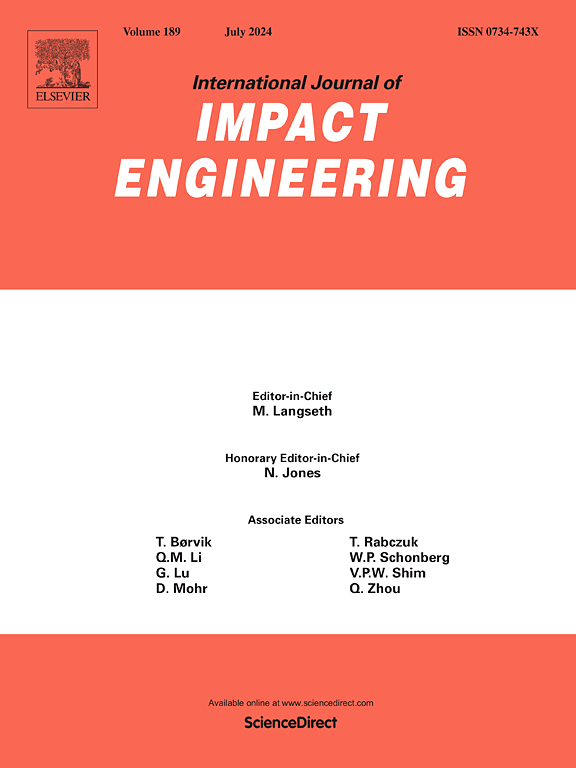基于图网络的可学习模拟器,用于硬质射弹穿透的时空预测
IF 5.1
2区 工程技术
Q1 ENGINEERING, MECHANICAL
International Journal of Impact Engineering
Pub Date : 2024-09-19
DOI:10.1016/j.ijimpeng.2024.105123
引用次数: 0
摘要
硬质射弹的板穿透(PPRP)预测在末端弹道学中至关重要,在民用和军事工程中有着广泛的应用。经验和分析方法在预测目标板材的位移和应力等现场变量方面面临挑战。数值方法虽然精度高,但计算效率低。在此,我们介绍一种基于图神经网络(GNN)的高效数据驱动机器学习(ML)方法,名为 PGN,专门用于解决 PPRP 问题。与建立直接输入输出映射的传统 ML 方法不同,PGN 预测的是弹丸与目标相互作用过程的综合时空信息。对 PGN 的精度、计算效率和泛化能力进行了全面分析。与数值模拟的验证结果相比,PGN 保持了较高的精度,位移、应力和应变预测的均方根误差分别低于 0.5%、9.5% 和 2.1%。在弹丸速度和加速度的时间历程方面,PGN 的 R2 值也超过了 0.92,而计算时间仅为 LS-DYNA 的 9.8%。在泛化测试中,PGN 在处理远远超出训练数据分布的挑战性场景时表现出了出色的适应性,总体 RMSE 在 11 % 到 13 % 之间。此外,我们还发现,模拟物理系统的最大信息传播能力必须满足或超过其所要复制的真实世界物理现象的信息传播需求。因此,我们提出了一种直接根据目标介质中的波速确定按摩传递法临界连通半径的方法,大大提高了 PGN 的精度和效率。本文章由计算机程序翻译,如有差异,请以英文原文为准。

A graph network-based learnable simulator for spatial-temporal prediction of rigid projectile penetration
Predicting plate penetration by rigid projectiles (PPRP) is crucial in terminal ballistics, with broad applications in civil and military engineering. Empirical and analytical methods face challenges in predicting field variables like displacement and stress in target plates. Although numerical methods offer high accuracy, they suffer from low computational efficiency. Herein, we introduce an efficient data-driven machine learning (ML) method based on graph neural networks (GNNs), named PGN, specifically tailored to address the PPRP problem. Unlike traditional ML methods that establish direct input-output mappings, PGN predicts comprehensive spatial-temporal information pertaining to the projectile-target interaction process. A thorough analysis of PGN's performance in terms of accuracy, computational efficiency and generalization ability was performed. Compared to validated results of numerical simulations, PGN maintained high precision with RMSE for displacement, stress, and strain predictions below 0.5 %, 9.5 %, and 2.1 %, respectively. It also achieved R2 values exceeding 0.92 for the time history of projectile velocity and acceleration, while requiring only 9.8 % of the computation time compared to LS-DYNA. In generalization tests, PGN exhibited remarkable adaptability in tackling challenging scenarios that extend far beyond the training data distribution, with overall RMSE between 11 % and 13 %. Furthermore, we find that the maximum information propagation capacity of a simulated physical system must meet or exceed the information propagation need of the real-world physical phenomenon it aims to replicate. Consequently, an approach was proposed to determine the critical connectivity radius of the massage passing method directly from the wave speed in the target medium, which greatly improved the accuracy and efficiency of PGN.
求助全文
通过发布文献求助,成功后即可免费获取论文全文。
去求助
来源期刊

International Journal of Impact Engineering
工程技术-工程:机械
CiteScore
8.70
自引率
13.70%
发文量
241
审稿时长
52 days
期刊介绍:
The International Journal of Impact Engineering, established in 1983 publishes original research findings related to the response of structures, components and materials subjected to impact, blast and high-rate loading. Areas relevant to the journal encompass the following general topics and those associated with them:
-Behaviour and failure of structures and materials under impact and blast loading
-Systems for protection and absorption of impact and blast loading
-Terminal ballistics
-Dynamic behaviour and failure of materials including plasticity and fracture
-Stress waves
-Structural crashworthiness
-High-rate mechanical and forming processes
-Impact, blast and high-rate loading/measurement techniques and their applications
 求助内容:
求助内容: 应助结果提醒方式:
应助结果提醒方式:


